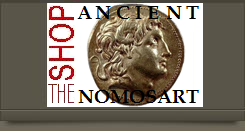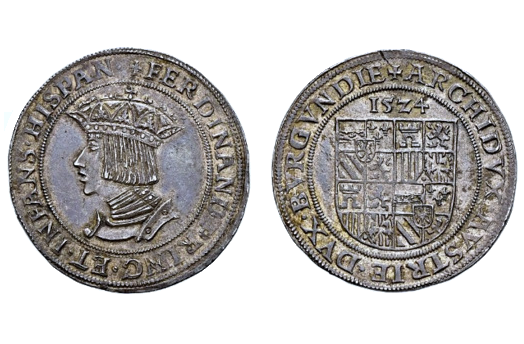
about ancient nomos
Ancient Nomos Art is a museum of galleries exhibiting ancient coins and ancient mint maps. The coin gallery displays the diverse art and history of hand-crafted ancient Greek, Roman, Byzantine, Persian and Medieval coinage. The ancient mints mapping gallery features Greek, Roman, Byzantine, Asia Minor and Medieval mint city regions and territories. Visitor's are welcome to explore, study and enjoy Ancient Nomos Art.

Post-Medieval Vienna – 1524 AD
King Ferdinand I
From Ancient Galleries

Obverse: Early Renaissance style bust of Ferdinand facing left draped, armored and crowned wearing an archduke's headdress.
Reverse: Quarterly coat-of-arms of origin including his ten kingship regions of dominion (see below); dated 1524 above.
LEGENDS
Obv: +FERDINAND(us) • PRINC(eps) • ET • INFANS • HISPAN(iarum) “Spanish ruler and infante (prince)” bust of Ferdinand facing left draped, armored and crowned wearing an archduke’s headdress. Rev: +ARCHIDVX • AVSTRIE • DVX • BVRGVNDIE “Archduke of Austria and Duke of Burgundy” quarterly coat-of-arms of origin including; Austria, 2 of Burgundy, Brabant with escutcheons of Flanders, Tyrol, Castile, León, Aragón, both Sicilies and Granada; dated 1524 above.
This spectacular post-medieval denomination above is known as a Pfunder. The Pfunder silver coin mintages were one of the forerunners denominations issued just prior to the famous period of Holy Roman Taler coinage. By the end of the 15th century, the rapid development of trade, the lack of coins of higher value and the shortage of gold at the same time, gave rise to the effort to supplement or replace gold coins by large silver coins. The first of these were the Venetian Grosso and Milanese Testone (1472-1474), followed by the Tyrolean Pfundner and Half Guldiner. Guldiners were issued by Lorraine in 1488, and the Swiss cantons of Bern (1491), Sitten (1498) and Basel (1499). In 1499, the Kremnica Mint also made its first attempt to introduce large silver coins. All these coins were small in number and are now considered rather rare. Originally, the Archduke Sigismund of Tyrol introduced the Pfundner [= 1 pound (240) pennies] in 1482 AD. Ferdinand followed this tradition, but gave the silver Pfunder a new design in the style of the Renaissance. Ferdinand I was born in 1503 in Spain and educated at the court of his grandfather Fernando de Aragón in the Spanish tradition. However, he had to leave Spain in 1517 when his brother Charles V arrived with his Dutch court to become King of Spain. In 1521/22 Charles V ceded him Austria, Styria, Carinthia and Craina, the Tyrol, western Austria and the Habsburg-occupied Württemberg. Ferdinand became King of Bohemia and Hungary, following his brother-in-law Louis II, who died fighting the Turks (Battle of Mohács 1526). Ferdinand united Austria, Bohemia and Hungary, which helped to shield Europe from the Turks. In 1531 Ferdinand was elected Roman King and thus the Emperor’s governor and successor.
DOCUMENTATION
Value: Pfunder. Metal: AR Silver. Weight: 5.75 grams. Mint: Wien (Vienna) mint. Date: 1524 AD.
Attribution: Markl, Die Münzen, Medaillen und Prägungen mit Namen und Titel Ferdinand I. Prague, p.474; WAG 46, 1727; Ex. Annemarie und Gerd Köhlmoos Collection Numismatic Rarities and Masterpieces, 1366 (this coin).
Legend, Documentation and Attribution
